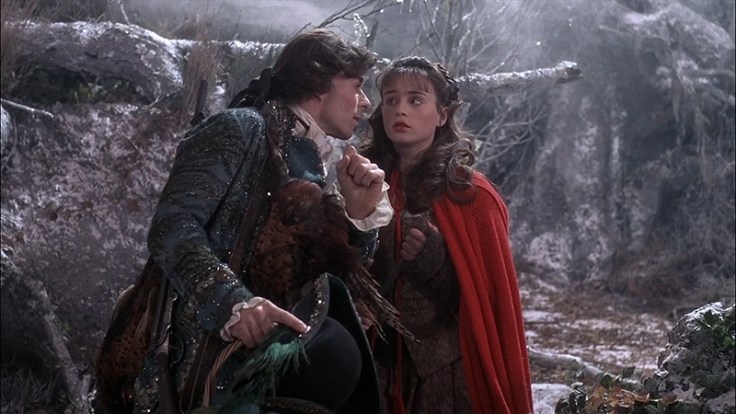Movie Review – Children of the Corn (1984)
There are certain horror films that I recall seeing at a fairly young age, most likely because they were frequently shown on television during the 1980s. One of my earliest conscious memories of watching a horror movie multiple times, where I could anticipate the pacing and the sequence of scenes and quote dialogue, was Stephen King’s Children of the Corn (1984). It was also my first real introduction to King. Carrie (1976), The Shining (1980), and most of the other adaptations until then, save for Creepshow (1982), which even as a kid I found more fun than scary, felt very adult to me. I had seen parts of them on television at various points but I don’t recall watching them wholly until I was a few years older. Their imagery was frightening – The Shining made my midnight trips to the bathroom speedy as I imagined the woman in the bathtub just on the other side of the plastic shower curtain that brushed against my elbow as I stood before the toilet – yet they were dealing with themes for which I at the time had no context.
But Children of the Corn, with its cast of young heroes and villains, was more approachable and easier for me to follow and immerse myself within. It dealt with childhood fears of losing your parents and it brought bullying to an extreme. Malachai (Courtney Gains) was most frightening because we all knew a kid in school or in the neighborhood that had the potential to become like him, if given the opportunity. Young Joby and Sarah were around my age and became avatars for kids like me, seeing the proceedings through their experience and believing that I too could be instrumental in thwarting evil, even helping the adults to accomplish what their ineptitude consistently sabotaged. Children of the Corn may also have been an early lesson in the dangers of theocracy, a cautionary tale emblazoned upon my young mind that still very much guides my ethical and philosophical identity.

So it is no wonder that my memory of this film, and I imagine many of my generation feel the same, is one of fondness. Of course, not everything ages well, and the last time I had watched the film before recently revisiting it was as a teenager more than fifteen years prior. Needless to say, I’m a very different person now, and especially as a father I knew that for the first time I would be seeing the movie through not only an experienced adult perspective, but also through the adult protagonists’ eyes.
Children of the Corn was the directorial debut of Fritz Kiersch and is certainly his most well-known film. Kiersch’s career would quickly peter, though he did manage to direct the ridiculously campy action-fantasy Gor in 1987. The two adults, Burt and Vicky, who find themselves in the parricidal, theocratic ghost town of Gatlin, Nebraska, are played by Peter Horton, who went on to a successful career in television, and Linda Hamilton. Hamilton, of course, rose to fame playing Sarah Conner in The Terminator (1984) which was released the same year. In all respects that film, with the sole exception of Hamilton’s hair, has aged better than Children of the Corn.
As an adult viewer I cannot dismiss the glaring plot-holes that puncture the story like clumsy sickles. As a child with little experience I could buy into the idea that a town could go off the map in modern America and be run by murderous kids for three years without anyone coming to check up on things. Postal or produce deliveries? Extended family? Utility crews? No, sir! Apparently, everyone just stopped coming to Gatlin or got fooled by a couple of misplaced road signs. Of course, this and more could all be fixed, or at least allow for more suspension of disbelief, if the film had simply stated that the opening murders had taken place three months, or better yet, three weeks earlier. Even as a kid I noticed that none of the kids seemed to age over those three years’ time. Similarly, “He Who Walks Behind The Rows,” the malevolent entity that the kids worship, is vulnerable to the corn being damaged, but there’s no corn for most of the year. Whence, then, goes our main baddy during that time?
These problems generally stem from the fact that the source material was a very short story by King which was published in the 1978 collection Night Shift. Things were necessarily added to extend the story but we get logical inconsistencies along the way. The movie starts fairly strong but meanders as it continues, unable to maintain the atmosphere of dread and mystery that pervades the beginning. The script also veers from the short story in both tone and substance, making for very different endings, and what the film offers as a resolution is ultimately unsatisfactory.
All these shortcomings having been said, there are still things that this movie does right. The music harkens back to the supernatural horrors of the 1970s and helps to create, at times, a creepy atmosphere. There are effective images that stay with viewer, such as the kid being struck by the car, the Blue Man, or Isaac staring through the diner window. Truly, John Franklin as Isaac is alone worth viewing the film, as his performance as the child preacher is charismatic and energetic and perfectly embodies what that character needed to be. Though child-like, Franklin suffered from a growth hormone deficiency when he was young and was actually twenty-five when he filmed the movie. Not knowing this about the actor the viewer will gather an uneasy sense that there is something disturbing about the character of Isaac beyond his murderous preaching – he has a confident gravitas beyond his years that wonderfully suits and serves the story.

In regard to the themes, it’s easy to see commentary on the Religious Right and on Reaganism, particularly with its treatment of religion as being largely dangerous if left unchecked. Ronald Reagan became president in 1980 largely from the support of the self-proclaimed “silent majority” (a term first popularized by Nixon) which included Christian and social conservatives like anti-feminist Phyllis Shafly and televangelist Jerry Falwell, who told millions of Americans in the 1980 election that “God is calling millions of Americans in the so-often silent majority to join in the moral-majority crusade to turn America around.” Liberal Americans, and especially those in Hollywood, felt adrift in this new conservatively aligned nation. Stephen King himself, an out-spoken liberal, has been openly critical over the years of Reagan and the Republican Party.
Seen through this lens, the characters of Burt and Vicky are surrogates for a left-leaning, secular America, lost in what is to them an alien landscape of endless corn. Burt is revealed early on to be in the medical field en route to his new assignment. This suggests that he is generally scientifically minded and, through his ability to resist the sexual advances of Vicky so as to stay on schedule and to shrug off her remarks about commitment, appears to be a man who doesn’t let emotions or lust derail his mental focus. As the couple drive through an ocean of corn they jokingly mock a radio preacher who has “no room for the homosexuals!” revealing a mutual disdain for socially conservative religion. When they strike the child in the road Burt is quick to assess that there is more going on, once again approaching the situation with a cold, rational mind. As they search the kid’s suitcase they find a crucifix made from corn that Vicky finds ugly and Burt concludes to be, as might an anthropologist, like a primitive form of folk art. Other scenes like this follow, and though the ending of the film muddles things with awkward monologues about religion from Burt or a vague biblical passage that they somehow make absurd leaps of logic to conclude is helpful, this theme of a secular, liberal America being encroached upon by conservative extremism is still very potent.

Another aspect of religion is suggested throughout the film, and though I’ve seen only bits and pieces of the many poor sequels they seem to misunderstand what made the tragedy of Gatlin possible. The children in the town are brainwashed, but they are far from being mind-controlled. Instead, their upbringing in a religiously conservative environment made the ascension of “He Who Walks Behind The Rows” possible. Joby talks of how Isaac was a popular child preacher, apparently embraced by the community and held in high regard. Children are an appropriate vehicle for zealotry because they are the most susceptible to indoctrination. In the end, it was Gatlin’s predisposition to adopt a charismatic, fundamentalist brand of Christianity that made Isaac’s influence possible – their own openness to extremist rhetoric and irrationality for solutions (in this case prayer to end a drought for a good corn harvest) allowed their children to take it a step further. As Burt says to the kids, “Maybe you’ve been listening to these holy rollers so long that it’s all starting to sound the same.” Like any cultists, the kids are seen in the beginning wearing contemporary teenage clothes, but after the murders have adopted plain, conservative attire. They have outlawed pleasure in the forms of the music and secular art. The only people who are not swayed are the natural skeptics, for Joby says that he and Sarah had always found Isaac weird. The old man at the gas station appears to have been an outcast even before the children took over and was possibly not a religious participant, and perhaps his isolation is partly why he had been allowed to live for so long. When warning Burt to avoid Gatlin, he simply states, “Folks in Gatlin got religion. They don’t cotton to outsiders.” The first part of his explanation seemed like reason enough to steer clear from the town. (IMDB has the quote as saying “Folks in Gatlin’s got a religion. They don’t like outsiders,” but I’m pretty sure this rendition is inaccurate.)
Children of the Corn is a flawed film, but it does stick with you. It may be riddled with logical inconsistencies, but it still offers deep enough concepts to chew on. Just as I was enamored with it as a child, I feel like it is actually a more effective children’s horror film than an adult one. That is not necessarily a bad thing. The 1980s had many horror movies best appreciated by a younger audience, like 1987’s The Gate, and their potency to viewers who are in those formidable years should not be dismissed or devalued. Children of the Corn is a perfect film to show a budding pre-teen horror fan who can handle some minor gore. They will not only relate more closely to the child characters and their plight, but they may learn, as I did, to be skeptical the next time someone tells them what God wants or an adult condescends to promise them the keys to the kingdom. “Folks in Gatlin got religion,” the film will remind them, “What you wanna do is to go to Hemmingford…”
Grade: C+






